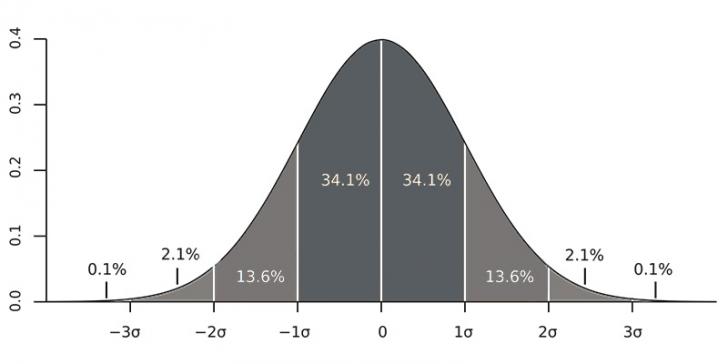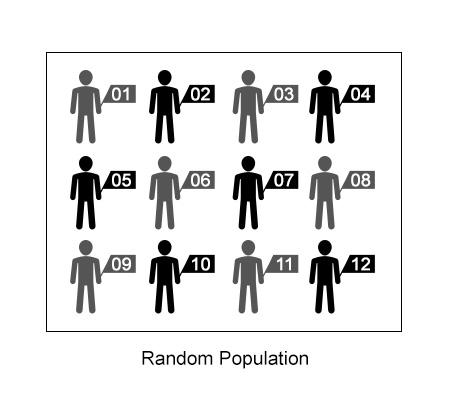Learning about any subject requires you to learn about the terminologies used in that subject. Sampling also has some technical terminologies that you should understand before you can start understanding the various sampling techniques and their advantages.
1. Population
Population is the collection of the elements on which you are required to analyze and draw a conclusion. The population includes all the items under consideration for the particular case study and is usually very large. Population is generally denoted by the Greek letter Sigma ( $sigma$ )
For Example, If you are going to survey about the favorite subjects of high school students of a certain school, the population ( $Sigma$) is the total students in that school.
2. Unit
Each component of the population being studied is known as a unit of the population. Some or many of these units are chosen as samples for further analysis and deduction.
For example
- A student, when we are sampling students.
- An arbitrary resident person in an area, when we are going to conduct survey about the residents of that area.
3. Strata
The section of the population chosen by taking more or less homogeneous units together is called a stratum and the plural form of a stratum is called strata. Items are classified into strata during Stratified Random Sampling.
For Example
- Group of Single Billionaires
- Group of Models who have married multiple times
4. Sample Frame
The collection of the elements from which you will be drawing samples is known as Sample Frame. Sample Frame can be the same as Population or a part of the Population in some cases. Sample Frame must be significantly larger than the Sample Size to obtain higher level of accuracy in our results. The Sample Frame must be representative of the whole population.
5. Sample
The items taken from the population for analysis (for deduction of hypothesis or arriving at a conclusion) are samples. These can be chosen is various ways.
- Probability Sampling
The various Sampling methods allow the users to assign each of the items in the population with the equal chance of getting selected. - Non- Probability Sampling
These techniques do not focus on the equal chances of getting selected. They focus on certain traits/characteristics of the items and select them if they fall in such categories.
6. Sample Size
The size of the total samples to be taken constitutes the sample size. This is the collection of all the samples taken. Sample size can vary on the following factors:
- Size of the Population
- Variability on the Population
- Required Level of Accuracy
7. Generalizing
The process of making an opinion or overall view on specific group by investigating and analyzing some of the evidences is known as generalizing. Generalizing enables us to use the results obtained from the study of a situation into other similar situations.
For Example, if the literacy of Samdrup Jongkha ( A district of Bhutan) of Bhutan was 53% on 2007. This means that the literacy rate of the whole nation Bhutan might be close to that number.
8. Validity
Validity means accuracy, truthfulness and authenticity. In the current context, the validity of an information can be defined as the sufficiency of the information on the subject matter with reasonable truthfulness and without any biasness on the representation of the overall characteristics of the whole population.
9. Bias
Lack of justice to the items due to different reasons which affects the validity and efficiency of the system is termed as bias. Biases restrict the conclusion or opinion drawn on on the population to represent the whole system. Biasness may occur due to different reasons. Some of the reasons for biasness in the system are:
- Lack of knowledge of the persons carrying out the system on the subject matter.
- Collusion of interests of the person carrying on the system and that of the whole system.
- Inherent reasons like laziness, lack of enough resources, monotony etc.
10. Sampling Error
The error that occurs because the samples are not the true representatives of the population is known as Sampling Error.
In other words, the deviation of the conclusion or view on any population from the actual status of the population due to the inappropriate samples or very tiny size of the samples is called Sampling Error.
11. Systematic error
The errors due to wrong use of equipment or the data handling system used or due to the inappropriate usage of the theories is called Systematic errors.
For Example
- The inaccuracy in the recorded temperatures caused by poor thermal contact between the thermometer and the system of which the temperature is to be recorded.
- Differences between actual average temperature and the recorded average solar radiation of a place due to cliffs, trees and other barriers.
12.Random Error
The errors due to unpredictable reasons like interpreter’s wrong interpretations of the reading of the device or other similar reasons.
For Example
The thickness of a sheet of paper measured three times was found as:
0.030303 0.03125 0.028571
The variation in the measurement of the thickness of the same sheet of paper was different, this was due to Random Error.
13. Sampling Fraction
The ratio of the sample size(n) of a survey to the size of the population (N) is known as Sampling Fraction.
14. Sampling Distribution
The pattern of a sample group will be somehow similar to the same of another group. Such a pattern is called Sampling Distribution.

15. Oversampling
The repetition in taking a sample multiple times is known as Oversampling.
